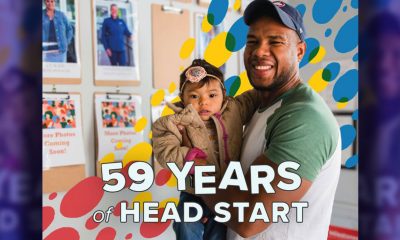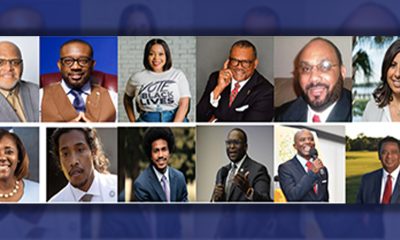Politics
Blacks Still Underrepresented at All Levels of Politics


Joint Center for Political and Economic Studies President Spencer Overton says there is a heated debate over how much progress we have made over the past 50 years. (Courtesy Photo)
By George E. Curry
NNPA Editor-in-Chief
WASHINGTON (NNPA) – Although Blacks have made tremendous improvement in holding elected office since passage of the 1965 Voting Rights Act, they remain underrepresented at the federal, state and local levels, according to a report scheduled to be released Tuesday by the Joint Center for Political and Economic Studies.
“Based on the most recent data, African Americans are 12.5% of the citizen voting age population, but they make up a smaller share of the U.S. House (10%), state legislatures (8.5%), city councils (5.7%), and the U.S. Senate (2%),” the report said.
The 38-page report titled, “50 Years of The Voting Rights Act: The State of Race in Politics,” was produced for the center by four prominent political scientists: Khalilah Brown-Dean, Zoltan Hajnal, Christina Rivers and Ismail White.
Joint Center President Spencer Overton said in a message introducing the report, that there is a heated debate over: How much progress have we made since 1965? How much more work is there to do?
He said, “These are contested questions, subject to ideology and opinion. A study published in Perspectives on Psychological Science, for example, shows that on average whites and African Americans differ on the amount of racial progress we have made, with whites now believing anti-white bias is more prevalent than anti-black bias. We have elected an African American president, but studies have shown that some government officials are less likely to respond to inquiries from citizens with seemingly black or Latino names. The questions are also at the core of many ongoing debates about voting rights in the U.S. Supreme Court and Congress, as well as in many states, counties, and municipalities.”
What is not contested is that the Voting Rights Act of 1965 changed the political landscape for African Americans, with the number of Black elected officials leaping from fewer than 1,000 in 1965 to now more than 10,000.
The change was particularly dramatic in the South, where 55 percent of African Americans live.
“Since the 1870s, white elected officials in many parts of the South had used violence, literacy tests, interpretation tests, poll taxes, and other devices to exclude African Americans,” the report recounted. “The Justice Department filed 71 voting rights lawsuits in the Deep South before 1965, but cases were typically complex, time-consuming, and expensive. When a court struck down one type of discriminatory device, local officials simply erected a different device that effectively excluded most African Americans.”
Selma, Ala. and surrounding Dallas County was typical. Deploying rigged tests about the U.S. Constitution and a requirement that voters be in “good character,” as defined by White registrars, a White minority was able to suppress the Black majority.
In 1965, more than half of Dallas County was Black. Of the county’s 15,000 voting-age Blacks, only 156 were registered to vote. By contrast, two-thirds of voting-age Whites were registered in the county. Throughout Alabama, only 19.4 percent of African Americans were registered. In neighboring Mississippi, just 6.4 percent of Blacks were registered.
As part of a massive voter registration campaign in 1965, the Southern Christian Leadership Conference (SCLC), the Student Nonviolent Coordinating Committee (SNCC) and local residents launched a Selma-to-Montgomery March to dramatize the lack of access to the ballot box.
On April 7, in what became known as “Bloody Sunday,” peaceful marchers in Selma were savagely beaten by Alabama State Troopers and local policemen as they attempted to walk across the Edmund Pettus Bridge to begin the 54-mile journey to Montgomery, the state capital.
The merciless beating of children, the elderly and adults was beamed in homes throughout the nation and provided the momentum for President Lyndon B. Johnson to sign the Voting Rights Act into law four months later.
“Only in the wake of the Voting Rights Act did black voter registration in the South begin to approach that of whites. Five years after the passage of the Act, the racial gap in voter registration in the former Confederate states had closed to single digits. By the start of the 1970s, the black/white registration gap across the Southern states was little more than 8 percentage points,” the report stated.
“In Louisiana, the gap between black and white voter registration rates decreased by nearly 30 percentage points from 1960 to the end of 1970s, and it continued to decrease over the next three decades. By 2010, black registration rates in the state of Louisiana and many of the other former Confederate states had exceeded white registration rates for the first time since Reconstruction. The Voting Rights Act had delivered a Second Reconstruction.”
In fact, in four of the 12 presidential elections since 1965, Black Southerners turned out at the polls at a higher rate than their White counterparts. Nationally, Black turnout exceeded White turnout in the 2012 presidential election and possibly in 2008, according to the report.
Activists credit much of that progress to the Voting Rights Act requirement that jurisdictions that previously discriminated against Blacks had to pre-clear voting changes in advance with federal authorities.
However, the Supreme Court’s decision in Shelby took away that tool and there is a measure pending in Congress that would reverse some of the damage. A House bill sponsored by “Bloody Sunday” veteran John Lewis (D-Ga.) and Jim Sensenbrenner (R-Wisconsin) would update the act.
“The proposed legislation would apply preclearance to jurisdictions with a record of voting rights violations within the previous 15 years, would make it easier for courts to block discriminatory rules before they are used in elections and harm voters, and would require disclosure of voting changes nationwide,” the report stated.
Efforts to expand the Black vote is also under attack in others quarters as well. The Joint Center report cited moves to purge voters, requiring proof of citizenship, requiring voter ID, felony disenfranchisement and restricting voting registration drives.
The report also addressed the elephant in the room – race.
“In urban local elections, race is a more decisive factor than income, education …religion, sexuality, age, gender, and political ideology. The 38-point racial gap exceeds even the 33 point gap between Democratic and Republican voters,” the study said.
According to the report, African Americans “were the least advantaged group in America in terms of policy outcomes.”
Not all of the problems were external. The issue of low Black voter turnout, especially in local elections, is a major challenge that warrants further study, the report said.
It noted, “ …In 2014, when there was great unrest over a police officer’s killing of Michael Brown, African Americans made up 67% of residents of Ferguson, Missouri. In 2012, a solid 100% of Ferguson precincts went for President Obama, but during Ferguson’s municipal off-cycle elections voters selected Ferguson’s Republican mayor and six city council members, all of whom except one were white.”
The report shatters the notion that we’re living in a post-racial society.
“Despite discussions about the declining significance of race, over the past few decades, racial divides along partisan lines have actually grown. African Americans have increasingly favored Democrats, and recently Latinos and Asian Americans have become more loyal to the Democratic Party as well. The shift to the left has been particularly pronounced for Asian Americans,” it said.
“On the other side, whites have moved slowly and unevenly – but inexorably – to the Republican Party. Fifty years ago, the Democratic Party dominated the white vote. Today, nationwide, whites are more apt to favor the Republican Party.”
It concluded, “Division is a normal and healthy part of democracy, but when a core dividing line in a nation becomes so closely aligned with race and ethnicity, larger concerns about inequality, conflict, and discrimination emerge.”
###


































